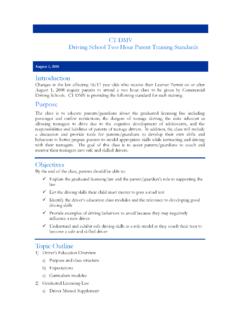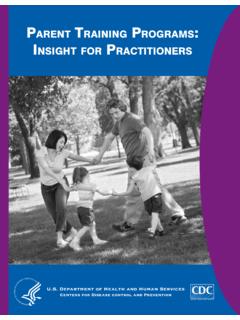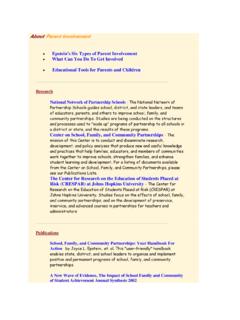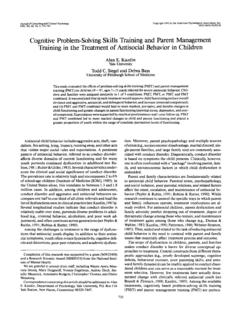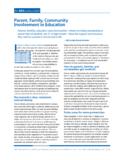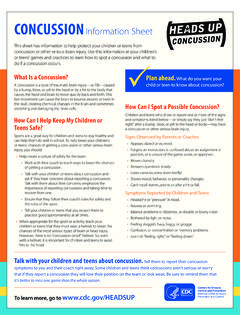Transcription of About the PRIDE Model
1 PRIDE /ADOPT PRIDE About the PRIDE Model 2 About the PRIDE Model Purpose PRIDE is a Model for the development and support of resource families. It is designed to strengthen the quality of family foster care and adoption services by providing a standardized, structured framework for recruiting, preparing, and selecting foster parents and adoptive parents. It also provides foster parent inservice training and ongoing professional development. PRIDE is the result of a national cooperative effort. The program was developed through a multi-year project initiated by the Illinois Department of Children and Family Services. The project involved the collaboration of 14 state child welfare agencies, one private family foster care agency operating in several states, one foster parent association, two national resource centers, one foundation, and several universities and colleges.
2 The name was selected by foster parents and adoptive parents in Illinois. It stands for Parent Resources for Information, Development, and Education. The program is based on the philosophy that the value of family life for children, however family is defined, is compelling. Because of this, knowledgeable and skilled foster parents and adoptive parents are integral to providing quality services. They, like social workers, should be qualified, prepared, developed, selected, and licensed or certified to work as members of a professional team equipped to protect and nurture children and strengthen families. The PRIDE Program s goals are to help: 1. Meet the protective, developmental, cultural, and permanency needs of children placed with foster families and adoptive families. 2. Strengthen families, whether they are families of origin, blended families, extended or kinship families, foster families, adoptive families, or members of a tribe or clan.
3 3. Strengthen the quality of family foster care and adoption services by providing a standardized, structured framework for preservice training and mutual assessment; for foster parent inservice training ; and for ongoing professional development. 4. Share resources among public and voluntary child welfare agencies, colleges and universities, foster parent and adoptive parent associations, and national child welfare organizations. Competency-based Approach PRIDE is based on specific competencies (knowledge and skills) needed to perform successfully the tasks of foster and adoptive care. This approach begins with an analysis of those tasks. Specific activities needed to complete tasks are identified. Next, these tasks are formulated into a written role description. The role description establishes the expectations for the foster parent and adoptive parent role.
4 3 After describing the tasks, the agency must ensure that foster parents and adoptive parents perform them. The PRIDE Program offers agencies an approach to training that builds necessary competencies. In the PRIDE Program, these competencies have been grouped into categories. The competencies also are arranged in sequence according to when they need to be learned, and organized by levels of depth of knowledge/skills involved. Competency Categories The PRIDE Program has established the following five essential competency categories: protecting and nurturing children; meeting children s developmental needs and addressing developmental delays; supporting relationships between children and their families; connecting children to safe, nurturing relationships intended to last a lifetime; and working as a member of a professional team.
5 These competencies drive the entire mutual assessment, selection, preparation, support, and development process of resource families. Sequence of Competencies The PRIDE program has identified preservice competencies for foster parents and adoptive parents, and core, advanced, and specialized competencies for foster parents. Preservice competencies are essential before a child is placed with a foster family or adoptive family. These competencies are addressed in the Foster PRIDE /Adopt PRIDE Preservice training . An example of a preservice competency is Foster parents and adoptive parents know the importance of promoting a child s positive sense of identity, history, culture, and values to help develop self-esteem. The Foster PRIDE /Adopt PRIDE training program addresses competencies and learning objectives that are shared by the fostering and adopting roles, and some that are specific to each.
6 A list of the adoption specific preservice competencies can be found in the Appendix. It is also recommended that state, county, and/or agency specific information, especially as related to the legal process of adoption, be inserted as indicated in the curriculum. PRIDE Core Module Eight covers additional adoption competencies for those states, counties, and/or agencies that have further requirements for adoption certification or licensing. Core competencies are those competencies required of all foster parents, regardless of the child s condition or conduct. Core competencies are addressed in the modules of the Foster PRIDE Core training Program. They guide the agency s efforts to provide ongoing support to foster families. Core competencies are more effectively learned after the foster parent is licensed, certified, or approved, and a child is placed.
7 They should be developed in the first two years of experience. An example of a core competency is Foster parents can support visits and other contact with child s family. Note: While the Foster PRIDE Core was written for foster parents, many of the competencies addressed may also be helpful to adoptive parents. It is recommended that the agency invite adoptive parents to attend modules of interest to them. As foster parents become more experienced, they will need advanced and specialized competencies. Advanced competencies build upon core competencies to further develop knowledge and skills that improve a foster parent s abilities to provide for children in care, and to work as a member of a professional team. An example of an advanced competency is Foster parents know the agency approved methods to de-escalate aggressive behavior, prevent assaults, and provide physical restraint, 4 and can use them appropriately.
8 Specialized competencies relate to a particular area of expertise, such as working with teen parents, caring for medically fragile infants, or preparing youths for independent living. An example of a specialized competency is Foster parents can use caregiving strategies to maximize the development of children who have been prenatally exposed to alcohol and other drugs. Preservice competencies for foster parents and adoptive parents and core, specialized, and advanced competencies for foster parents can be found in the Appendix. Note: The Foster PRIDE /Adopt PRIDE training program addresses preservice competencies and learning objectives that are shared by the fostering and adopting roles, and some that are specific to each. A listing of the adoption specific competencies can be found in the Appendix.
9 The revised FosterPRIDE/Adopt PRIDE curriculum addresses these adoption competencies. Some states and localities may have additional requirements for adoption certification that go beyond the identified competencies. In this situation it is recommended that the PRIDE Core Module 8: Promoting Permanency Outcomes be utilized to cover additional adoption competencies. Session Two of this module focuses solely on the adoption process. In addition, agencies will need to be prepared to cover state or locale specific information regarding the legal process of adoption, as legal procedures vary greatly across the country. A Progression of Learning In addition to the hierarchy of competencies that foster parents need to develop, there is also a progression of learning related to their performance of tasks.
10 This progression consists of four levels of competencies, as defined by the Institute for Human Services:* The first level, Awareness, is achieved when foster parents acquire a conceptual framework for organizing new information. They become aware of why something is important to learn. A competency statement that reflects this desired level would state, for example, The foster parent is aware of the human need for connections and attachments. This awareness is critical to being able to understand the effects of separation and loss. For the second level of competence, Knowledge/Understanding, foster parents must have comprehensive, factual information. Using the example of separation and loss, a foster parent would know the stages of grieving as related to separation and loss. Understanding is a higher level of knowledge: the ability to integrate knowledge with observed behavior.
